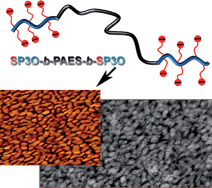A new class of highly-conducting polymer electrolyte membranes: Aromatic ABA triblock copolymers
Abstract
Highly

* Corresponding authors
a
WCU Department of Energy Engineering, Hanyang University, Seoul, Republic of Korea
E-mail:
Michael.Guiver@nrc-cnrc.gc.ca, ymlee@hanyang.ac.kr
b School of Chemical Engineering, College of Engineering, Hanyang University, Seoul, Republic of Korea
c Department of Chemical Engineering, National Tsing Hua University, Hsinchu, Taiwan
d R&D Center for Membrane Technology, Chung Yuan Christian University, Chungli, Taoyuan, Taiwan
e Institute for Chemical Process and Environmental Technology, National Research Council, Ottawa, Ont, Canada
Highly

 Please wait while we load your content...
Something went wrong. Try again?
Please wait while we load your content...
Something went wrong. Try again?
N. Li, S. Y. Lee, Y. Liu, Y. M. Lee and M. D. Guiver, Energy Environ. Sci., 2012, 5, 5346 DOI: 10.1039/C1EE02556B
To request permission to reproduce material from this article, please go to the Copyright Clearance Center request page.
If you are an author contributing to an RSC publication, you do not need to request permission provided correct acknowledgement is given.
If you are the author of this article, you do not need to request permission to reproduce figures and diagrams provided correct acknowledgement is given. If you want to reproduce the whole article in a third-party publication (excluding your thesis/dissertation for which permission is not required) please go to the Copyright Clearance Center request page.
Read more about how to correctly acknowledge RSC content.
 Fetching data from CrossRef.
Fetching data from CrossRef.
This may take some time to load.
Loading related content
